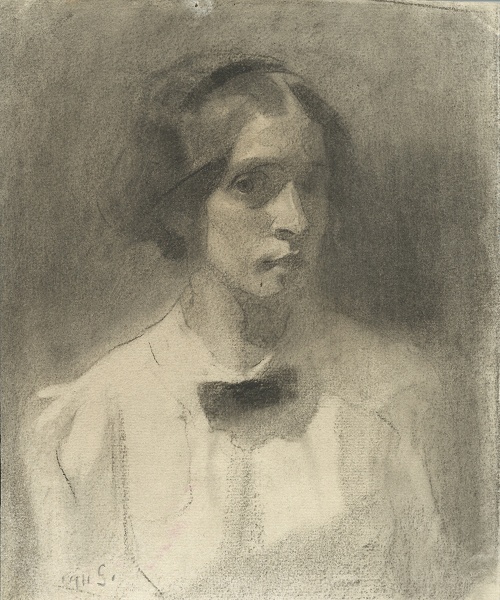

 Hover over the painting to magnify (there may be an initial delay while the magnified image is loaded)
Hover over the painting to magnify (there may be an initial delay while the magnified image is loaded)Edith Granger-Taylor (1887-1958):
Self Portrait, 1911
Framed (ref: 7277)
Pencil and black chalk
Signed with initial, dated
9 1/2 x 8 in. (24.2 x 20.3 cm)
See all works by Edith Granger-Taylor pencil artists at work portraits women 1.Master Drawings 1.PORTRAIT OF AN ARTIST Fifty Works by Fifty British Women Artists 1900 - 1950 WOMEN women portraits Mercer
Provenance: Private Collection
Literature: Llewellyn, Sacha, and Paul Liss. Portrait of an Artist. Liss Llewellyn, 2021, p.256.
It is always a great pleasure to see a ‘new’ work by my grandmother, especially a self-portrait. ‘Edie’, as she was known, died five years before I was born, but as I grew up she was always a very real presence in my life, in that the walls of the family home in Barnes were covered in her pictures and those by her sister-in-law, and frequent model, Olive Deakes. It was Edie’s self-portraits in particular that held my attention: we had a large pastel, c. 1920, and a smaller oil from 1908 – the latter I am blessed to have inherited. Her look in the former is aloof, distant – in the latter haunting, haunted. Now, decades later, she emerges in this different portrayal, that is softer, less guarded. The slightly raised brow and the ghost of a smile give a lighter aspect, and a new facet to the cumulative image I have of her.
In this – at first glance – relatively academic self-portrait study, the emphasis is on light and dark: the soft rendering of the hair, blending with the dark background, throws our attention onto the illuminated portion of the face, which is also framed by the black hairband and black bow. Alongside these traditional pictorial devices we notice an element of more contemporary abstraction: a fluid, gestural line which marks off the forms into flat shapes, such as the sharp-edged shadow cast on the neck. Meanwhile, in her oil studies of this period, Edie was beginning to emphasise an aspect of colour and shape – of pattern – that would come to define her later, more ‘modern’ and often near-abstract style.
Commentary by Nicolas Granger-Taylor. Nicolas is a painter primarily of portraits, nudes and still lives and an art tutor. He graduated from the Royal Academy Schools in 1990 and is the grandson of Edith Granger-Taylor.
 Unsung Heroines
Unsung Heroines SOLD
SOLD




